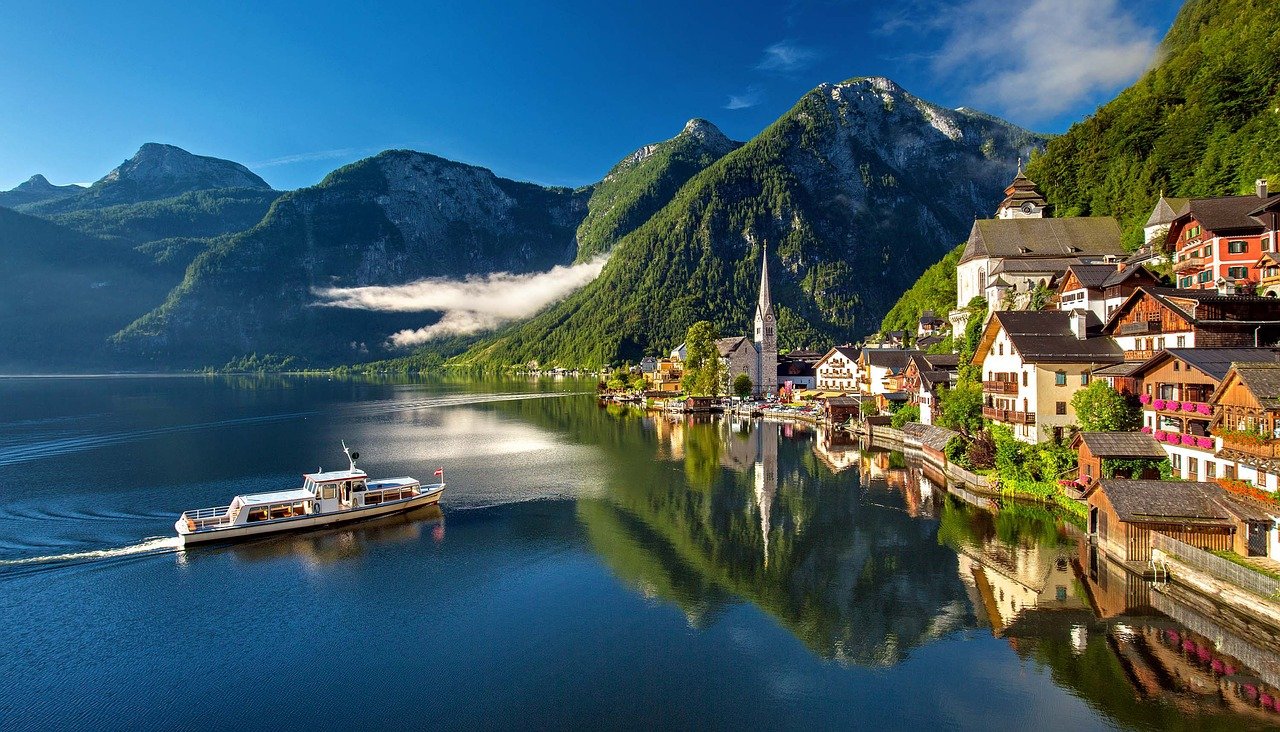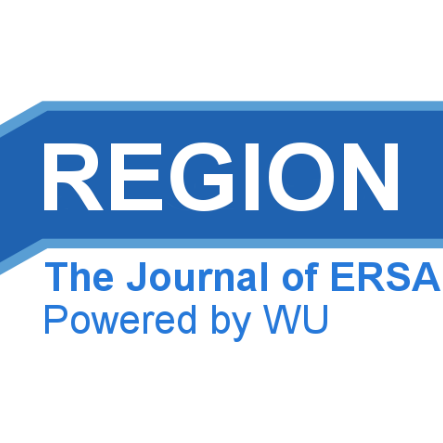Territory and Sustainable Tourism Development: a Space-Time Analysis on European Regions
DOI:
https://doi.org/10.18335/region.v4i3.142Abstract
In the long run, tourism competitiveness depends on the sustainable use of territorial assets: the differentiation of destinations depends on the integration of cultural and natural resources into the tourism supply, but also on their preservation over time. The link between competitiveness and sustainability is the staring point for our analysis of the relationships between regional tourism competitiveness, the dynamics of tourism demand and investment and the existence of natural resources and cultural assets in European regions, by using advanced spatial econometric techniques. Despite the close relationship between tourism activities and the characteristics of the territory, the application of methods of spatial analysis methods in tourism studies is still scarce and the results of this work clearly show their potential for this field of research. Among the main findings of this paper, it was observed that natural resources do not have the expected positive impacts on regional tourism competitiveness and that European regions with more abundant natural resources are often developing unsustainable forms of mass tourism, with low value added and scarce benefits for the host communities. The existence of spatial correlation effects suggests that positive spillovers arising from tourism dynamics in neighbourhood regions prevail over potential negative effects related to the competition between destinations. Policy and managerial implications of these results are discussed and further research questions are suggested.
References
Anselin L (2005) Exploring Spatial Data with GeoDaTM: A Workbook. Center for Spatially Integrated Social Science, Santa Barbara
http://la1.rcc.uchicago.edu/media/geoda_files/docs/geodaworkbook.pdf
Anselin L (2010) Thirty years of spatial econometrics. Papers in Regional Science 89: 3-25
http://onlinelibrary.wiley.com/doi/10.1111/j.1435-5957.2010.00279.x/full
Anselin L, Lozano-Gracia N (2008) Errors in variables and spatial effects in hedonic house price models of ambient air quality. Empirical Economics 34: 5-34
http://link.springer.com/article/10.1007%2Fs00181-007-0152-3
Baltagi S, Jung B, Koh W (2003) Testing Panel Data Regression Models with Spatial Error Correlation. Journal of Econometrics 117: 123–150
http://www.sciencedirect.com/science/article/pii/S0304407603001209
Baltagi S, Jung B, Koh W (2007) Testing for Serial Correlation, Spatial Autocorrelation and Random Effects Using Panel Data. Journal of Econometrics 140(1): 5-51
http://www.sciencedirect.com/science/article/pii/S0304407606002223
Benur A, Bramwell B (2015) Tourism product development and product diversification in destinations. Tourism Management 50: 213-224
http://www.sciencedirect.com/science/article/pii/S0261517715000412
Buhalis D (1999) Limits of tourism development in peripheral destinations: problems and challenges. Tourism Management 20: 183-185
http://epubs.surrey.ac.uk/1114/1/fulltext.pdf
Buhalis D (2000) Marketing the competitive destination of the future. Tourism Management 21: 97-116
http://www.sciencedirect.com/science/article/pii/S0261517799000953
Butler R (1999) Sustainable tourism: A state‐of‐the‐art review. Tourism Geographies 1(1): 7-25
http://www.tandfonline.com/doi/abs/10.1080/14616689908721291
Camisón C, Forés B (2015) Is tourism firm competitiveness driven by different internal or external specific factors?: New empirical evidence from Spain. Tourism Management 48: 477-499
http://www.sciencedirect.com/science/article/pii/S0261517715000047
Celant A (2007) Global Tourism and Regional Competitiveness. Patron, Bologna
Cliff A, Ord J (1981) Spatial Processes, Models and Applications. Pion, London
Coccossis H (2002) Tourism Development and Carrying Capacity. In Apostoulos G, Gayle D (eds.) Island Tourism and Sustainable Development (131-143). Praeger, Westport
Cracolici M, Nijkamp P (2008) The attractiveness and competitiveness of tourist destinations: A study of Southern Italian regions. Tourism Management 30: 336–344
http://www.sciencedirect.com/science/article/pii/S026151770800112X
Croissant Y, Millo G (2008) Panel data econometrics in R: The plm package. Journal of Statistical Software 27(2): 1-43
http://th.archive.ubuntu.com/cran/web/packages/plm/vignettes/plm.pdf
Cuccia T, Guccio G, Rizzo I (2016) The effects of UNESCO World Heritage List inscription on tourism destinations performance in Italian regions. Economic Modelling 53: 494-508
http://www.sciencedirect.com/science/article/pii/S0264999315003454
Cucculelli M, Goffi G (2016) Does sustainability enhance tourism destination competitiveness? Evidence from Italian Destinations of Excellence. Journal of Cleaner Production 111: 370-382
http://www.sciencedirect.com/science/article/pii/S0959652614013663
Douglas J (2014) What's political ecology got to do with tourism?. Tourism Geographies 16(1): 8-13
http://www.tandfonline.com/doi/abs/10.1080/14616688.2013.864324
Dwyer L, Kim C (2003) Destination Competitiveness: Determinants and Indicators. Current Issues in Tourism 6(5): 369-414
http://www.tandfonline.com/doi/abs/10.1080/13683500308667962
Elhorst J (2003) Specification and Estimation of Spatial Panel Data Models. International Regional Science Review 26: 223-243
http://irx.sagepub.com/content/26/3/244.abstract
Elhorst J. (2014) Spatial Econometrics: From Cross-Sectional Data to Spatial Panels. Springer, New York
http://www.springer.com/us/book/9783642403392
Enright M, Newton J (2004) Tourism destination competitiveness: a quantitative approach. Tourism Management 25: 777–788
http://www.sciencedirect.com/science/article/pii/S0261517704001347
European Commission (2007) Agenda for a Sustainable and Competitive European Tourism. European Commission, Luxembourg
http://eur-lex.europa.eu/legal-content/EN/TXT/?uri=celex:52007DC0621
Florax R, Vlist A (2003) Spatial Econometric Data Analysis: Moving Beyond Traditional Models. International Regional Science Review 26(3): 23-243
http://irx.sagepub.com/content/26/3/223.short
Gilbert D (1984) The need for countries to differentiate their tourist product and how to do so. Seminar papers: Tourism managing for results. University of Surrey, United Kingdom
Hassan S (2000) Determinants of market competitiveness in an environmentally sustainable tourism industry. Journal of Travel Research 38(3), 239–245
http://jtr.sagepub.com/content/38/3/239.full.pdf+html
Hong W (2009) Global competitiveness measurement for the tourism sector. Current Issues in Tourism 12(2): 105-132
http://www.tandfonline.com/doi/full/10.1080/13683500802596359
Huybers T, Bennett J (2003) Environmental Management and the Competitiveness of Nature-Based Tourism Destinations. Environmental and Resource Economics, 24: 213–233
http://link.springer.com/article/10.1023/A:1022942001100
Kang S, Kim J, Nicholls S (2014) National Tourism Policy and Spatial Patterns of Domestic Tourism in South Korea. Journal of Travel Research 53(6): 791–804
http://jtr.sagepub.com/content/53/6/791.full.pdf+html
Jafari J (2001) The Scientification of Tourism. In Smith V, Brent M (eds) Hosts and Guests Revisited: Tourism Issues of the 21st Century. Cognizant Communication Corporation, New York
Kapoor M, Kelejian HH, Prucha IR (2007) Panel Data Model with Spatially Correlated Error Components. Journal of Econometrics 140(1): 97–130
http://www.sciencedirect.com/science/article/pii/S0304407606002259
Kozak M (1999) Destination Competitiveness Measurement: Analysis of Effective Factors and Indicators. European Regional Science Association Conference Papers, Dublin
http://www-sre.wu-wien.ac.at/ersa/ersaconfs/ersa99/Papers/a289.pdf
Kozak M, Martin D (2012) Tourism life cycle and sustainability analysis: Profit-focused strategies for mature destinations. Tourism Management 33: 188-194
http://www.sciencedirect.com/science/article/pii/S0261517711000653
Lu J, Nepal SK (2009) Sustainable tourism research: an analysis of papers published in the Journal of Sustainable Tourism. Journal of Sustainable Tourism 17(1): 5-16
http://www.tandfonline.com/doi/full/10.1080/09669580802582480
Ma T, Hong T, Zhang H (2015) Tourism spatial spillover effects and urban economic growth. Journal of Business Research 68(1): 74-80
http://isiarticles.com/bundles/Article/pre/pdf/45210.pdf
Majewska J (2015) Inter-regional agglomeration effects in tourism in Poland. Tourism Geographies 17(3): 408-436
http://www.tandfonline.com/doi/full/10.1080/14616688.2014.997279
Marrocu E, Paci R (2013) Different tourists to different destinations - Evidence from spatial interaction models. Tourism Management 39, 71-83
http://www.sciencedirect.com/science/article/pii/S0261517712001896
Martín J, Mendoza C, Román C (2015) A DEA Travel–Tourism Competitiveness Index. Social Indicators Research, 1-21
http://link.springer.com/article/10.1007/s11205-015-1211-3
Mazanek J, Wober K, Zins A (2007) Tourism Destination Competitiveness: From Definition to Explanation?. Journal of Travel Research 46: 86-95
http://jtr.sagepub.com/content/46/1/86.full.pdf+html
Milo G, Piras G (2012) splm: Spatial Panel Data Models in R. Journal of Statistical Software 47(1): 1-38
https://www.jstatsoft.org/article/view/v047i01/v47i01.pdf
Navickas V, Malakauskaite A (2009) The Possibilities for the Identification and Evaluation of Tourism Sector Competitiveness Factors. Engineering Economic, 1(61): 37-44
http://eis.ktu.lt/index.php/EE/article/view/11581
O'Brien R (2007) A Caution Regarding Rules of Thumb for Variance Inflation Factors. Quality and Quantity 41(5): 673-690
http://link.springer.com/article/10.1007/s11135-006-9018-6
Park J, Jang S (2014) An Extended Gravity Model: Applying Destination Competitiveness. Journal of Travel & Tourism Marketing 31(7): 799-816
http://www.tandfonline.com/doi/full/10.1080/10548408.2014.889640
Patuelli R, Mussoni M, Candela G (2013) The effects of World Heritage Sites on domestic tourism: a spatial interaction model for Italy. Journal of Geographical Systems 15, 369–402
http://link.springer.com/article/10.1007/s10109-013-0184-5
Poon A (1994) The ‘new tourism’ revolution. Tourism Management 15(2): 91-92
http://www.sciencedirect.com/science/article/pii/0261517794900019
Porter M (1985) Competitive advantage - creating and sustaining superior performance. The Free Press, New York
Porter M (2003) The economic performance of regions. Regional Studies 37(6/7): 549-578
http://www.tandfonline.com/doi/abs/10.1080/0034340032000108688
Ritchie J, Crouch G (2003) The competitive destination: A sustainable tourism perspective. CABI International, Oxfordshire
Romão J (2015) Culture or Nature: a space-time analysis on the determinants of tourism demand in European regions. Discussion Papers Spatial and Organisational Dynamics 14
http://www.cieo.pt/discussionpapers/discussionpapers14.pdf#page=35
Sharpley R. (2009) Tourism Development and the Environment: Beyond Sustainability?. Earthscan, London.
Song H, Dwyer L, Cao Z (2012) Tourism Economics Research: A Review and Assessment. Annals of Tourism Research 39(3): 1653-1682
http://www.sciencedirect.com/science/article/pii/S0160738312000795
Torres-Delgado A, Saarinen J (2014) Using indicators to assess sustainable tourism development: a review. Tourism Geographies 16(1): 31-47
http://www.tandfonline.com/doi/full/10.1080/14616688.2013.867530
Tsai H, Song H, Wong K (2009) Tourism and Hotel Competitiveness. Journal of Travel and Tourism Marketing 26(5): 522-546
http://www.tandfonline.com/doi/full/10.1080/10548400903163079
UNESCO (2000) Sustainable Tourism and the Environment. UNESCO, Paris
UNESCO (2005) World Heritage Centre - Sustainable Tourism Programme. UNESCO, Paris
UNWTO (2007) Practical Guide to Tourism Destination Management. UNWTO, Madrid
Vanhove N (2005) The Economics of Tourism Destinations. Elsevier, Oxford
Wall G, Mathieson A (2006) Tourism: Change, Impacts and Opportunities. Pearson, Essex
Weaver D (2006) Sustainable tourism: Theory and practice. Elsevier, Oxford
Webster C, Ivanov S (2014) Transforming competitiveness into economic benefits: Does tourism stimulate economic growth in more competitive destinations?. Tourism Management 40: 137-140
http://www.sciencedirect.com/science/article/pii/S0261517713001222
Williams A, Shaw G (2011) Internationalization and Innovation in Tourism. Annals of Tourism Research 38(1): 27–51
http://www.sciencedirect.com/science/article/pii/S016073831000126X
Williams P, Ponsford I (2009) Confronting tourism’s environmental paradox: Transitioning for sustainable tourism. Futures 41: 396–404
http://www.sciencedirect.com/science/article/pii/S0016328708002164
World Economic Forum (2008) The Travel & Tourism Competitiveness Report 2008. World Economic Forum, Geneva
World Commission on Environment and Development. (1987) Our Common Future. Oxford University Press, New York
World Tourism Organization (1993) Sustainable Tourism Development: Guide for Local Planners. WTO, Madrid
Yang Y, Fik T (2014) Spatial effects in regional tourism growth. Annals of Tourism Research 46, 144–162
http://www.sciencedirect.com/science/article/pii/S0160738314000346

Published
How to Cite
Issue
Section
License
Copyright (c) 2017 João Romão, João Guerreiro, Paulo M. M. Rodrigues

This work is licensed under a Creative Commons Attribution 4.0 International License.
REGION is an open journal, and uses the standard Creative Commons license: Copyright We want authors to retain the maximum control over their work consistent with the first goal. For this reason, authors who publish in REGION will release their articles under the Creative Commons Attribution license. This license allows anyone to copy and distribute the article provided that appropriate attribution is given to REGION and the authors. For details of the rights authors grant users of their work, see the "human-readable summary" of the license, with a link to the full license. (Note that "you" refers to a user, not an author, in the summary.) Upon submission, the authors agree that the following three items are true: 1) The manuscript named above: a) represents valid work and neither it nor any other that I have written with substantially similar content has been published before in any form except as a preprint, b) is not concurrently submitted to another publication, and c) does not infringe anyone’s copyright. The Author(s) holds ERSA, WU, REGION, and the Editors of REGION harmless against all copyright claims. d) I have, or a coauthor has, had sufficient access to the data to verify the manuscript’s scientific integrity. 2) If asked, I will provide or fully cooperate in providing the data on which the manuscript is based so the editors or their assignees can examine it (where possible) 3) For papers with more than one author, I as the submitter have the permission of the coauthors to submit this work, and all authors agree that the corresponding author will be the main correspondent with the editorial office, and review the edited manuscript and proof. If there is only one author, I will be the corresponding author and agree to handle these responsibilities.




